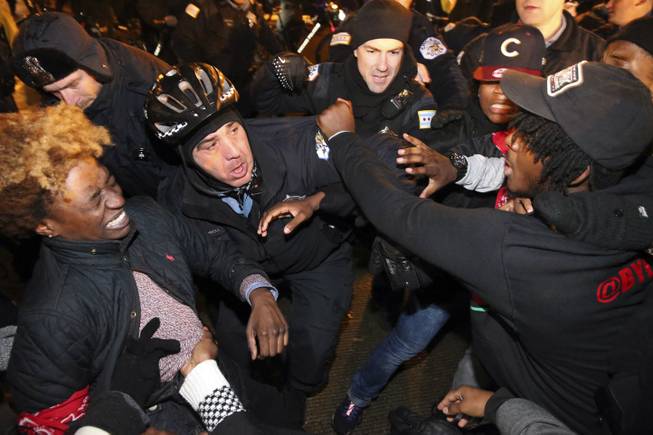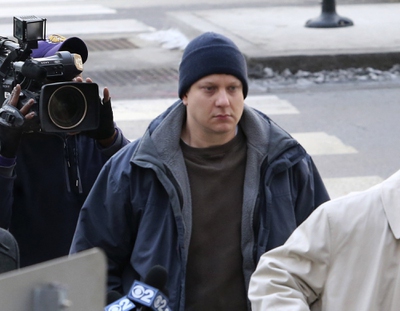
Nuccio DiNuzzo / Chicago Tribune via AP
Protesters scuffle with Chicago police on Tuesday, Nov. 24, 2015, in Chicago over the shooting death of Laquan McDonald last year by a white officer.
Wednesday, Nov. 25, 2015 | 12:20 a.m.
CHICAGO — A white Chicago police officer was charged with first-degree murder Tuesday in the death of a 17-year-old black man, just hours before city officials appealed for calm as they released a chilling video of the officer shooting the teenager as he lay crumpled on the ground.
The grainy, nighttime dashboard camera video, which a judge ordered released last week, shows the young man running and then walking past officers in the middle of the street and spinning when bullets suddenly strike him down. For a moment, lying on the ground, he moves but then is still after he appears to be shot several more times. An officer kicks an object away from his body. The video shows none of the officers on the scene offering assistance to the teenager, Laquan McDonald.
Standing with community leaders before releasing the video, Mayor Rahm Emanuel and Garry McCarthy, the Chicago Police superintendent, said they expected demonstrations in response to the graphic nature of the video and urged people to avoid violence. “It’s fine to be passionate, but it is essential that it remain peaceful,” Emanuel said.
The officer, Jason Van Dyke, 37, who has been with the Police Department for 14 years, is the first Chicago police officer in decades to be charged with murder in an on-duty shooting. The city previously fought to keep the video private, citing the continuing investigation.
Van Dyke was charged and the video released just over a year after McDonald was shot 16 times, even after he had stepped slightly away from the officer, prosecutors said. Witnesses said McDonald, who was carrying a 3-inch folding knife, never spoke to Van Dyke or any of the other officers and did not make threatening moves toward him. None of at least seven other police officers on the scene fired their weapons.
The NAACP, on Twitter, called it “unacceptable” that it took more than a year for the video to be released.
The family of McDonald, which had opposed the video’s release, issued a statement through its lawyers calling for calm. “No one understands the anger more than us, but if you choose to speak out, we urge you to be peaceful,” the family said. “Don’t resort to violence in Laquan’s name. Let his legacy be better than that.”
On Tuesday night, demonstrators gathered outside a police station in a neighborhood just south of downtown. Some spoke of a pattern of police misconduct and chanted “Sixteen shots! Sixteen shots!” Officers on bicycles stood by as police vehicles blocked off a portion of State Street. As of late Tuesday, the police had reported a handful of arrests.
In announcing the murder charge, Anita Alvarez, the Cook County state’s attorney, acknowledged that she had pushed to charge the officer before the video became public. “I made a decision to come forward first because I felt like, with the release of this video, that it’s really important for public safety that the citizens of Chicago know that this officer is being held accountable for his actions,” Alvarez said.
Since late last year, the shooting has been investigated by a team that included the FBI, the U.S. attorney’s office in Chicago and the Cook County state’s attorney’s office. But Alvarez said she decided to proceed with charges on her own when the videotape was ordered released. Federal charges are still possible, legal experts said, and federal authorities said their investigation was continuing.
Alvarez, a two-term Democrat who is seeking re-election in March, defended herself against suggestions that the investigation had taken too long, saying that such investigations into police shootings often take more than a year. And she rejected claims that she had buckled to political pressure by filing the charges before the video came out, saying she had reached a conclusion several weeks ago that charges were warranted.
Hours before the video’s release, a judge, Donald Panarese Jr., ordered Van Dyke held without bail, indicating that he wanted to see the video before revisiting the question of bond at a hearing Monday. Van Dyke faces 20 years to life in prison if convicted.
Dan Herbert, a lawyer for Van Dyke, has said the officer believed the shooting was justified because he feared for his safety and that of other officers. Herbert said his client “absolutely” intended to go to trial. Dressed in a beige sweater and jeans, Van Dyke said little during the brief hearing.
The charge and the release of the video came amid a national debate over race, police shootings and a growing number of violent encounters with the police captured on video. Chicago’s police force has its own sometimes painful history, which by some estimates includes more than $500 million in settlements and other costs over the past decade tied to police misconduct as well as reparations for black residents who said a group of officers abused and tortured them in the 1970s and ’80s.
In April, the city agreed to pay $5 million to the McDonald family, even before a lawsuit had been filed in the case.
On the evening of Oct. 20, 2014, police officers approached McDonald on the city’s Southwest Side, prosecutors said, after a resident reported seeing him breaking into trucks and stealing radios. McDonald, who had the folding knife in his hand, walked away as officers arrived. Someone called for a police unit with a stun gun, although it was not clear whether anyone ever appeared with one. At one point, McDonald “popped” the tire on a police car, apparently with his knife, the prosecutors said.
With more officers arriving car by car, McDonald kept walking and jogging along, not responding to orders to drop the knife, prosecutors said. Near a Burger King along a busy stretch of Pulaski Road, Van Dyke’s marked Chevrolet Tahoe pulled up alongside other police vehicles, including one containing a dashboard camera. Van Dyke was on the scene for fewer than 30 seconds, prosecutors said, before he began shooting his service weapon, which had a 16-round capacity. The shooting spanned 14 or 15 seconds, and in about 13 of those seconds, prosecutors say, McDonald was lying on the ground. He was hit 16 times, including in his backside. An autopsy showed the presence of the drug PCP in his system.
For months, the city had refused to release the video. On Thursday, Franklin Valderrama, a Cook County judge, ordered it released. The city initially indicated that it would appeal, but Emanuel announced that Chicago would release the video, and issued a statement condemning Van Dyke’s actions and calling for prosecutors to take prompt action.
“In accordance with the judge’s ruling, the city will release the video by Nov. 25, which we hope will provide prosecutors time to expeditiously bring their investigation to a conclusion so Chicago can begin to heal,” Emanuel said last week. On Monday, he met privately with community leaders and pastors.
Van Dyke has worked as a Chicago police officer since June 2001, records show. He had been on administrative duty pending the investigation, and on Tuesday was placed on no-pay status because of the criminal charge, McCarthy said.
Herbert, the officer’s lawyer, said Van Dyke was highly decorated with an excellent record and numerous awards. But records show that the officer had been the subject of numerous complaints from residents, including allegations of using excessive force and making racial slurs.
Herbert said that no merit had ever been found by the authorities in any of the allegations against Van Dyke.
The Chicago police are frequently involved in shootings, including 15 from July to September this year. But officers here rarely face charges for firing their weapons.
Dante Servin, a detective, is perhaps the most notable exception in recent memory. Servin was charged with involuntary manslaughter in a 2012 off-duty shooting that resulted in the death of Rekia Boyd, an unarmed black woman. A judge acquitted Servin this year.
Officials said McDonald was a ward of the state at the time of his death and was attending an alternative school, Sullivan House High School. “He was coming every day, joking and even giving hugs,” Thomas Gattuso, the principal, said in an interview.
Michael D. Robbins, a lawyer for McDonald’s family, said he had been raised, in large part, by a grandmother, who died in 2013. His mother had been working to regain custody before his death, Robbins said.
His mother has not been able to bring herself to watch the video, he said. “She is very, very distraught,” Robbins said Monday evening. “It’s a reminder about the loss of her son — and it’s going to come as this big, glaring, publicly displayed event. She is very emotional.”


Join the Discussion:
Check this out for a full explanation of our conversion to the LiveFyre commenting system and instructions on how to sign up for an account.
Full comments policy